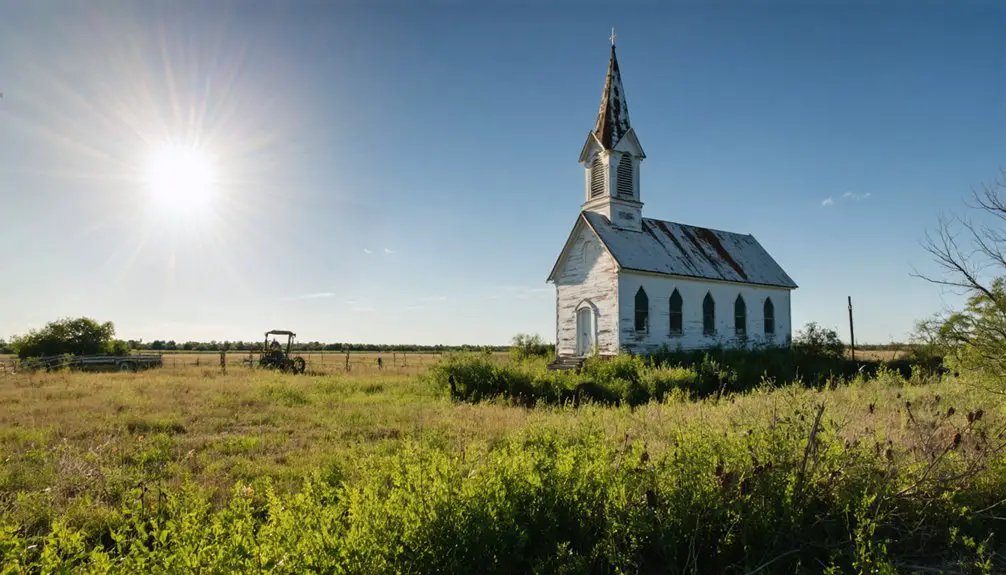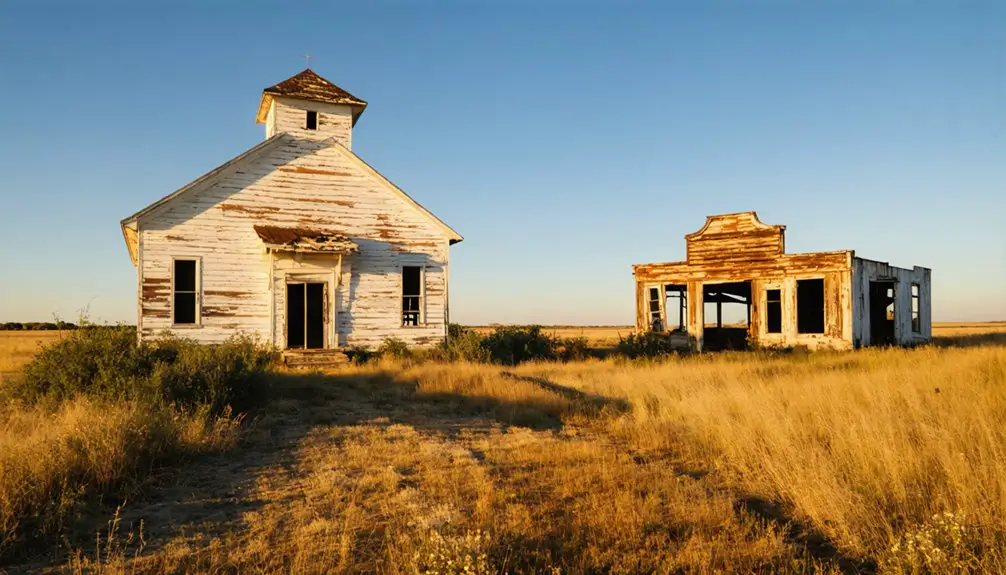You’ll find College Mound, Texas isn’t your typical ghost town. Located 5 miles southeast of Terrell in Kaufman County, this 1840s settlement maintains an active presence with around 350 residents. While its dream of hosting a college never materialized, the community’s Methodist church (established 1845) and cemetery (1846) remain as monuments to its resilience. Historical records reveal a rich tapestry of pioneer life, agricultural heritage, and determined settlers whose legacy continues to shape this remarkable rural community.
Key Takeaways
- College Mound retains active residents and landmarks, distinguishing it from typical ghost towns despite its diminished size from peak settlement times.
- The Methodist church and cemetery remain functioning community focal points, preserving the town’s historical significance since the 1840s.
- Unlike abandoned ghost towns, College Mound maintains a stable population of approximately 350 residents since 2000.
- Though its commercial elements declined, including the post office closure in 1874, the community preserved its cultural heritage through local institutions.
- The town’s namesake college was never built, but historical structures and agricultural traditions continue to support an active rural community.
Origins and Settlement History
As westward migration patterns flourished during early Texas statehood, College Mound emerged in the mid-1840s when settlers primarily from Indiana and Tennessee established a small farming community.
Their settler motivations centered on creating a new life in Texas, bringing with them agricultural practices and cultural influences from their home states.
You’ll find the settlement’s name originated from an educated Easterner’s vision to build a college on a prominent mound in the area. Though he died before realizing this dream, the name endured.
An ambitious Easterner dreamed of building a college atop a local mound, and though he never succeeded, his vision lives on.
Similar to Medicine Mound’s history, low land prices attracted early pioneers to the region.
The European-American settlers quickly established core institutions, including a Methodist church in 1845 and an adjacent cemetery in 1846.
These early developments reflected their determination to create a structured community that would preserve their values and traditions in their new Texas home.
The area became one of multiple College Mounds in various geographical locations across the United States.
Early Infrastructure and Development
While College Mound never grew into a major commercial hub, the settlement established essential infrastructure to support its agricultural community by the mid-19th century.
The earliest settlers were families from Indiana and other Midwestern states. You’d find several stores serving local farmers, along with a cotton gin that anchored the town’s agricultural focus. The post office, opened in 1850 under John L. Beck’s leadership, provided crucial communication services until 1874, despite interruptions during the Civil War.
Infrastructure challenges included the lack of railroad access, which limited growth compared to neighboring towns. Like the mining town of Medicine Mound, its decline was hastened by shifts in transportation and economic patterns. However, the Methodist church, built in 1845, served as a multi-denominational gathering space, while Farm to Market Road 429 connected residents to nearby Terrell.
The settlement’s utility needs remained basic, reflecting its rural character, though modern water and utility districts now serve the area.
Religious and Community Life
The vibrant religious life of College Mound centered around its Methodist church, established in 1845 as the settlement’s spiritual cornerstone. In 1866, W.T. Patton deeded land for a permanent church site, which was finally constructed in 1897. This building uniquely served five Protestant denominations, fostering unprecedented interdenominational relationships among Methodist, Presbyterian, Christian, Missionary Baptist, and Primitive Baptist congregations.
The church and its adjacent cemetery, established in 1846, became the heart of community gatherings through the 1980s. Like Belle Plain College, the church building served as an important educational institution for the local community. Today, the cemetery hosts an Annual Decoration Day to honor those who shaped the town’s history.
You’ll find that many church members were descendants of original settlers from Indiana and Tennessee, maintaining strong ties to their heritage. The well-maintained cemetery remains a reflection of College Mound’s enduring religious legacy, even as the town’s population declined to roughly 350 by 2000.
Educational Legacy and Dreams
Dreams of higher education gave College Mound its distinctive name, derived from an ambitious but unrealized plan to build a college atop a local hill. When the project’s key founder died before establishing the institution, those educational aspirations remained unfulfilled, though they forever shaped the community’s identity.
College Mound’s name stands as a poignant reminder of unfulfilled dreams, where education’s promise awaited atop a hill that never became reality.
The settlement adapted by creating a local school that served generations until 1949, when it merged with Terrell Independent School District. Like many other institutions such as Rosenwald School in Tatums, it played a vital role in rural education.
While the college never materialized, the community’s educational impact emerged through figures like William Madison McDonald, a prominent businessman and statesman born in College Mound.
The Methodist church supplemented formal education, serving as both a spiritual and learning center.
Though the original college dream faded, it exemplifies the challenges and determination of 19th-century rural Texas communities to establish educational foundations.
Population Changes Through Time
While you won’t find detailed census records for College Mound’s earliest days, historical documents indicate the settlement grew steadily from its mid-1840s founding to support a post office, multiple stores, and a multi-denominational church by the 1860s.
The community’s population remained modest throughout the late 19th century, experiencing the typical ebbs and flows of rural Texas settlements, including disruption during the Civil War period. This pattern of gradual decline mirrors communities like Belle Plain, which saw its population dwindle until only four families remained by 1897.
Early Settlement Peak Numbers
Population figures for College Mound’s early settlement remain largely undocumented, though evidence suggests steady growth from its mid-1840s founding through the late 19th century.
You’ll find the settlement demographics reflected in the community’s expanding infrastructure and early commerce. By 1850, they’d established enough of a population base to warrant a post office, and the town soon supported multiple stores and a cotton gin.
The settlement’s significance is further evidenced by its Methodist church, which served five denominations and received an official land deed in 1866. While exact numbers aren’t recorded, the community’s peak likely occurred in the late 1800s, when the permanent church structure was built in 1897.
The town maintained enough residents to support local schooling until 1949, when it merged with the Terrell district.
Modern Population Stability
Since the turn of the millennium, College Mound has maintained a relatively stable population, with approximately 350 residents recorded in 2000 according to the Handbook of Texas.
You’ll find limited population dynamics in this small unincorporated community, which stands in stark contrast to nearby suburban areas like Flower Mound that have experienced explosive growth. Based on recent data analysis, Flower Mound is projected to see continued growth patterns through 2035.
While precise recent census data isn’t available for College Mound specifically, the rural challenges faced by similar communities in the region suggest minimal population fluctuation.
Nearby Mound, Texas offers a glimpse into the socioeconomic factors affecting such small communities, with high poverty rates and demographic imbalances potentially contributing to population stagnation. The area’s poverty rate of 56.34% illustrates the significant economic challenges facing rural Texas communities.
Despite the Dallas/Fort Worth Metroplex’s rapid expansion, College Mound remains largely unchanged, maintaining its rural character rather than following suburban growth patterns.
Geographic Features and Location
You’ll find College Mound situated on a gentle rise within the prairie landscape of northeastern Texas, approximately 5 miles southeast of Terrell in Kaufman County.
The community’s namesake mound represents one of the few notable elevation changes in this mainly flat region, positioned at coordinates 32.67278°N and 96.18694°W.
Though technically part of the Dallas/Fort Worth Metroplex, the area retains its rural character with scattered farmland and historic structures amid the East Texas prairie and woodland environment.
Regional Terrain Analysis
Located in eastern Kaufman County, Texas, College Mound sits at coordinates 32.6729°N, 96.1869°W, with an elevation of 518 feet above sea level.
You’ll find the settlement nestled among gently rolling plains, where the terrain features support traditional agricultural practices like cotton farming and livestock grazing.
The landscape reflects typical northeastern Texas characteristics, with a mix of native grasses, hardwood trees, and brush scattered across undulating topography.
Small creeks weave through the area, though no major water bodies exist directly within the community.
The soil composition has historically sustained farming operations, while local groundwater remains accessible at relatively shallow depths.
You’ll notice the land use patterns showcase a blend of open pastures and wooded areas, maintaining the region’s rural character despite its proximity to the Dallas/Fort Worth Metroplex.
Dallas Metro Area Setting
As part of the Dallas/Fort Worth Metroplex’s eastern periphery, College Mound maintains its rural character while sitting approximately 5 miles southeast of Terrell along Farm to Market Road 429.
You’ll find this unincorporated community balancing its countryside appeal with urban influences from nearby cities. Despite its ghost town status, College Mound’s location offers strategic advantages for residents seeking both pastoral living and metropolitan access.
- You’re within a 30-40 minute drive of major educational institutions like Collin County Community College and Eastfield College
- Your commuting patterns can easily connect you to Dallas-area job markets via regional highways
- You’ll experience the freedom of country living while retaining access to Terrell’s amenities and services
The community’s position at 32.67278°N, 96.18694°W places you squarely in eastern Kaufman County’s gently rolling terrain, away from dense urban development.
Present-Day Landmarks and Status

Today’s College Mound stands as a tribute to its historical roots, with several key landmarks remaining from its early settlement period.
You’ll find the 19th-century Methodist Church still commanding attention as the town’s centerpiece, exemplifying historic preservation at its finest. The well-maintained cemetery offers a peaceful representation of the community’s dedication to honoring its past.
Unlike many Texas ghost towns that have completely vanished, College Mound maintains an active, albeit small, population.
You can access these historical sites via Farm to Market Road 429, where you’ll discover several original structures that have withstood time’s passage.
The community’s ongoing engagement with its heritage guarantees these landmarks don’t fall into disrepair, making it a unique example among Texas’s 500+ ghost towns that typically feature only abandoned ruins.
Frequently Asked Questions
What Happened to the Original Families Who Settled in College Mound?
Most original settlers’ descendants gradually moved away, though some family legacies continue through annual gatherings and cemetery maintenance. You’ll find their stories preserved through historical records and community memory.
Were There Any Notable Civil War Events in College Mound?
While countless stories echo through time, you won’t find any major Civil War battles in College Mound. Local legends tell of militia recruitment and postal disruptions, but the town mainly supported Confederate efforts from home.
What Crops Besides Cotton Were Grown in College Mound?
You’ll find that farmers practiced sorghum cultivation and crop rotation, growing corn as a major staple, alongside wheat, beans, and sweet potatoes to sustain their families and livestock throughout the seasons.
Did Any Famous People Ever Live in or Visit College Mound?
Like a lone star in Texas history, you’ll find only one famous resident: William Madison McDonald, a notable Black politician and banker. No other historical records show famous visitors.
What Natural Disasters Have Affected College Mound Throughout Its History?
You’ll find limited records of flood damage and tornado history affecting College Mound, though the region’s pattern of severe storms likely impacted the area throughout northeastern Texas’s documented weather events.
References
- https://www.hipcamp.com/journal/camping/texas-ghost-towns/
- https://en.wikipedia.org/wiki/College_Mound
- https://livefromthesouthside.com/10-texas-ghost-towns-to-visit/
- https://www.ghosttowns.com/states/tx/collegemound.html
- https://texashighways.com/culture/history/what-the-heck-is-a-ghost-town/
- https://texasescapes.com/CentralTexasTownsNorth/College-Mound-Texas.htm
- https://en.wikipedia.org/wiki/List_of_ghost_towns_in_Texas
- https://www.redriverhistorian.com/education
- https://www.tshaonline.org/handbook/entries/mound-tx
- https://www.timesrecordnews.com/story/entertainment/arts/2016/09/05/museum-monday-museum-tells-story-of-texas-ghost-town/92634188/



